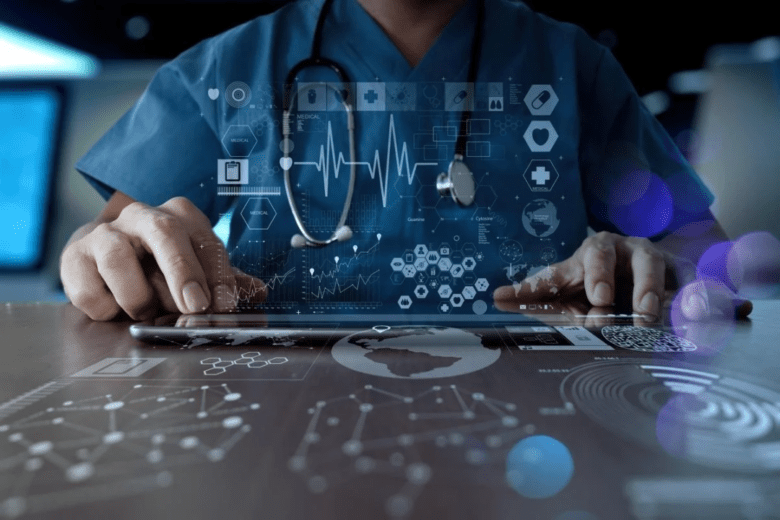Healthcare is undergoing a massive transformation because technology is changing so quickly. These new ideas not only make healthcare better but also simpler, faster, and more suitable for every patient. The introduction of new technologies, such as smart technologies and artificial intelligence (AI), in healthcare is changing the way care is delivered and how people experience it. This article discusses some of the most important innovations in healthcare technology that are changing the way healthcare is delivered and how patients are cared for.
1. Artificial Intelligence in Healthcare
One of the most important new ideas in healthcare is artificial intelligence (AI). Artificial intelligence technologies such as machine learning and natural language processing study large amounts of medical data to discover trends and make predictions. These options make the diagnosis more accurate and ensure that diseases are detected earlier. One example is where AI algorithms can look at medical images such as X-rays and MRIs and spot problems that humans may miss. This makes it possible to detect and treat diseases such as cancer and heart disease faster and more effectively.
Artificial intelligence is also used to develop more specific treatment plans for each patient by using data about each patient. AI can look at each patient’s genetic information, lifestyle factors, and medical background to suggest treatments that are likely to be more effective for them. This level of personalization can improve patient outcomes and reduce the chance of adverse effects from treatment.
2. Telemedicine and Remote Care
Since the outbreak of COVID-19, telemedicine has become an important part of modern healthcare. Patients can use the technology to talk to doctors who are far away, allowing them to use video conferencing, phone calls, or texting apps. Telemedicine makes healthcare more accessible, especially for people who live in rural or underserved areas and have difficulty traveling to medical centers.
Telemedicine has many more benefits than just convenience. It reduces the chance of infection spreading by reducing the number of in-person visits. This is especially important when infectious diseases are spreading. Telemedicine also allows doctors to monitor people with long-term problems so they can see how their health is changing and take quick action if necessary.
3. Health Equipment you Wear
Wearable health devices are changing the way people take care of their health. These gadgets, such as fitness trackers, smartphones, and biosensors, monitor your health and collect useful information about various bodily functions. Wearable technology can track heart rate, activity, sleep habits, and even blood oxygen levels, among other things.
Wearable technology can collect data that can be used to detect early signs of health problems and encourage people to see a doctor before things get worse. For example, if a smartwatch detects an irregular heartbeat, it could mean the user has atrial fibrillation and should see a doctor. This early help can prevent bigger problems and improve the situation for the patient.
4. Personalized Medicine
Personalized medicine, also known as “precision medicine,” is an approach that tailors treatments to a patient’s unique characteristics. This new idea draws on advances in genetics, biotechnology, and data analysis to understand how diseases begin genetically and molecularly. Healthcare professionals can look at a patient’s genes to find specific mutations or biomarkers that affect a patient’s response to certain treatments.
Personalized medicine is also being used to produce better drugs to treat other health problems, such as heart disease and autoimmune diseases. As experts learn more about the genetic factors that cause these diseases, they can develop treatments that are better suited to each patient. This approach not only improves patient health but also increases healthcare efficiency by reducing prescribing errors.
5. Application and Progress of Robots in Surgery
Robotic technology has made significant advances in surgery and rehabilitation by increasing accuracy, reducing recovery time, and improving patient outcomes. Using robot-assisted systems such as the da Vinci Surgical System, minimally invasive surgeries can be performed with greater precision and control. The surgical instruments in these devices are mounted on robotic arms and the surgeon controls them from a console. Greater precision reduces the risk of complications and damage to nearby tissue, helping patients recover faster and with less pain after surgery.
Robotic exoskeletons offer new possibilities for people with limited mobility during recovery. People who have suffered a stroke or spinal cord injury can regain mobility and continue their daily lives with the help of these wearable devices. Robotic exoskeletons are also used in physical therapy to strengthen muscles and train people to walk better. This will speed up the healing process.
6. Application of 3D Printing in Healthcare
3D printing is changing healthcare and making it possible to create the medical devices, implants, and even human tissue we need. Thanks to this new technology, it is now possible to create limbs and orthoses that perfectly fit everyone’s body. Modifying these gadgets to make them more comfortable and useful can improve patients’ quality of life.
In surgery, 3D printing is used to create accurate models of the body, helping doctors plan difficult operations. These models show and feel what the patient’s body will look and feel like, which helps with more accurate planning before surgery and reduces the risk of problems during surgery.
Conclusion
Key new health technologies are changing the way healthcare is delivered and how people experience it. From wearable technology and personalized medicine to artificial intelligence and online, these technologies improve patient care, make healthcare more accessible and effective, and open the door to new medical discoveries. As these innovations continue to develop, they have the potential to solve some of healthcare’s biggest problems and improve the lives of patients around the world.
FAQs
1. How can the health devices people wear improve service delivery?
Wearable health devices improve patient care by monitoring a patient’s health and collecting useful information about physiological parameters. These gadgets can detect early signs of health problems, encourage people to see a doctor, and help manage long-term conditions. Providers can use the data collected to develop treatment plans and provide more personalized care.
2. What is personalized medicine? How does it work?
Personalized medicine, also known as precision medicine, ensures that each patient receives care designed specifically for him or her. Personalized medicine looks at genetic information, lifestyle factors, and medical backgrounds to discover specific mutations or biomarkers that influence the effectiveness of the treatment. This approach can make treatment more effective and reduce side effects.
3. What role do robots play in surgery and rehabilitation?
Robotic technology improves surgery and recovery by making minimally invasive treatments more precise and controllable and helping people with limited mobility. Robot-assisted surgery speeds healing and reduces postoperative pain. Robotic exoskeletons could help people who have suffered a stroke or spinal cord injury regain mobility and perform daily tasks.
4. How can 3D printing help healthcare?
In healthcare, 3D printing technology can be used to create custom medical devices, implants, and anatomical models. This allows prosthetics and orthoses to be tailor-made for each patient, improving comfort and usability. 3D printing also makes it easier to plan surgeries and create bioprinted cells and organs that can be used in transplants and regenerative medicine.
5. How does blockchain technology make health data storage more secure?
Blockchain technology makes health data more secure by creating a decentralized, immutable record to track private health data. It protects the security and integrity of data, reduces the risk of data breaches, and makes it easier for healthcare systems to collaborate. Blockchain also simplifies everyday tasks, making healthcare operations more efficient.



